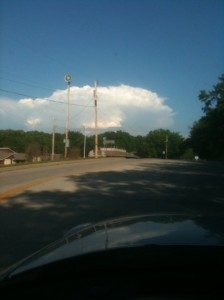Today Kathy Wright reflects on the tragedy of the 2011 Joplin tornado and the help and hope that foll0wed . . .
At around 5:00 p.m. on Sunday, May 22, 2011, I was driving home from my daughter’s baby shower at Johnstone Park in Bartlesville, Oklahoma. It was a lovely afternoon with clear skies and beautiful weather. Rounding the corner at the intersection of Silver Lake and Nowata Roads, this sight in the eastern sky took my breath away. It was the terrible beauty of a HUGE wall cloud.
Now, you don’t live in Oklahoma very long before learning what it means to see a cloud like this. Someone, somewhere, is experiencing “severe weather”. I snapped this photo with my phone because the cloud was so stunning, while at the same time sensing a sinking feeling in my stomach and saying a prayer for our neighbors who were in the path of that storm.
Our neighbors turned out to be Joplin, Missouri.
Nine months earlier, my friend Bud had taken a job as principal of East Middle School. His school was destroyed.
My friend Fritz’ family frantically searched for his 17-year old nephew, Lantz, immediately following the tornado. They found him four days later in the morgue. He was one of the 161 who lost their lives that day.
For Bartlesville, it was personal. We held fundraisers. We coordinated tornado relief drop-off points. We delivered aid in the form of food, clothing and willing hands to help Joplin deal with this incredible tragedy.
What happens AFTER the devastation of the costliest single tornado in U.S. history? Emergency responders deploy. People band together. Organizations collaborate. Disaster response teams kick into high gear. Countless groups spring into action bringing desperately needed help to those in peril. Funds pour into the community from federal, state and local sources to help make the city whole again.
But, it is never enough.
And so, the community is left to put itself back together. But they become weary. Progress seems to taper off. The stream of contributions slows to a trickle. People become discouraged.
Kent and I have been working with several leaders in Joplin as they rebuild the community. Besides the businesses and other community services investing money and time to rebuild, each nonprofit organization has similar challenges. Not only must they continue to serve pre-storm constituents but in many cases even MORE people need their services. Many must also repair or rebuild facilities. All of this takes additional funding from donors. And Joplin donors are fatigued.
But, here’s the thing. Donors, by definition, are giving people. Each donor has personal reasons for wanting to make this world a better place. Connecting on a deeper level with donors is important for both the nonprofit AND the donor.
But, how do we connect with donors? Kent and I are determined to be part of the solution. We’ve been invited to serve Joplin’s philanthropic community by providing a free workshop at 10:30 a.m. Tuesday, August 12:
GETTING IN:
How You can Connect with Major Funders
Whether you’re raising funds to advance your mission or simply want to build more genuine relationships, you won’t want to miss this engaging presentation.
320 East 4th Street
Joplin, MO 64801
(417) 624-4150
(Email me if you want details about attending this workshop.)
The good news for Joplin in 2014, three years later, is that 90% of the homes have been rebuilt. 450 of the 500 businesses affected have reopened. Bud’s new East Middle School building was dedicated earlier this year. Redevelopment plans are in the works. Joplin is looking forward. Spirits are lifting.
Citizens of Joplin, we salute you.
Kathy Wright, MHR
Chief Operating Officer
PS: Click here for more information on next week’s workshop.





 [caldera_form id="CF591c6f3f5221c"]
[caldera_form id="CF591c6f3f5221c"]



